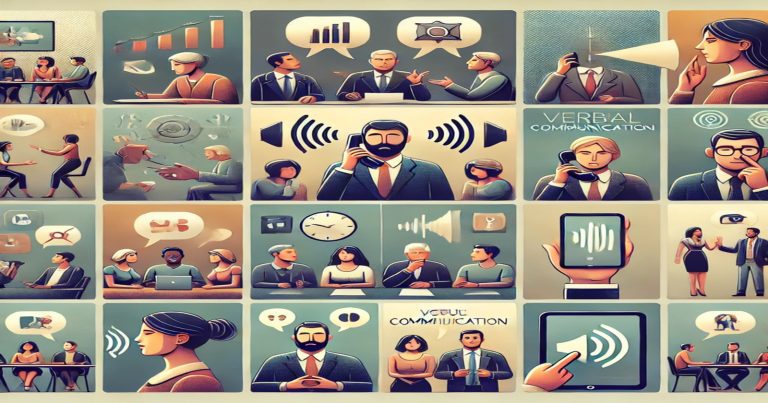Verbal communication refers to communicating using voice, either by speaking or writing words: it involves conversations, speeches, presentations, and sending text messages. Thus, it makes a person’s thoughts clear and also aids in understanding what others want. There are several types of verbal communication, including interpersonal, intrapersonal, small group, public, and mass communication.
What is Communication?
Communication can be defined as the passing of information, ideas, emotions, and messages between humans. Such communication can manifest in speech, writing, gestures, and facial expressions. The process of effective communication is making sure that one understands the content received. Such communication plays a major role in personal and professional life.
There isn’t any interaction between people without communication. It’s dating with friends or emailing someone with body language; it’s always there. communication channels help share knowledge, express feelings, and sometimes form new relationships. There are two types of communication: verbal communication (spoken or written) and non-verbal communication (body language, gestures, and facial expressions). Both forms go hand-in-hand to create a clearer and well-understood message.
Methods of Communication
People have many different ways of communicating. The basic types of communication include:
Verbal Communication
Verbal communication refers to communicating using voice, either by speaking or writing words: it involves conversations, speeches, presentations, and sending text messages. Thus, it makes a person’s thoughts clear and also aids in understanding what others want.
Non-verbal Communication
In that definition, non-verbal communication is the interpretation of body language, gestures, facial expressions, and even eye contact. It communicates emotion and intention without words. A smile shows happiness whereas, crossed arms may show a defensive attitude.
Written Communication
Written communication includes letters, emails, reports, and social media messages. It is generally used for formal communication and record-keeping. Lacking the spontaneity of verbal communication, written communication allows a person to store messages for future reference.
Visual Communication
Visual communication is a medium of communication that utilizes different pictures, graphs, charts, and videos to give information. It is usually very useful in data presentation and makes the messages attractive.
Among all these different types of ccommunication, verbal communication is the most directly known and widely used. Now, let’s go on to look at other types of it.
Verbal Communication
Verbal communication refers to communicating using voice, either by speaking or writing words: it involves conversations, speeches, presentations, and sending text messages. Thus, it makes a person’s thoughts clear and also aids in understanding what others want.
Advantages of Verbal Communication
- Quick and Direct: Info is shared right away.
- Clear Expression: Tone and voice help in understanding.
- Interactive: Gives scope for immediate feedback and clarification.
Disadvantages of Verbal Communication
- Miscommunication: Pronouncing a word or an English accent may lead to confusion.
- No Record: Verbal communication doesn’t leave any written evidence to refer to in the future.
- Nevertheless, there shall remain constant verbal communication with life as you know it.
Ways to Improve Verbal Communication
Improved verbal communication will help you become successful professionally and personally.
- Speak Clearly: Utilize proper pronunciation and the right tone.
- Build Your Vocabulary: Good vocabulary leads to a powerful way of communicating.
- Control Your Body Language: Your gestures should match your words; the same goes for facial expressions.
- Listen More: Listening gives you the possibility of responding much better.
Types of Verbal Communication
Verbal communication is the exchange and transfer of thoughts and ideas through the medium of spoken words. It expresses imagination, gives information, and builds relationships. All types of verbal communication can be found in various places, such as in the workplace, in a school, or at an interaction with someone in society.
Interpersonal Communication
Interpersonal communication can simply be defined as the process of exchanging parameters of some sort between two or more people. It may be informal or formal events depending on the context. Close relationship networks among people or business organizations are a part of everyday interaction.
Examples of Interpersonal Communication
- Talking to a friend about his or her personal experiences.
- Talking about a personal project with another coworker.
- A teacher explaining something to a student.
Key Features of Interpersonal Communication
- This promises to forge durable relations between people in both their private and professional scheme of things.
- Improves the ability of an individual to both solve problems and make decisions.
- It allows an individual to share his or her emotions and thoughts about themselves with others.
- Interpersonal communication helps in teamwork, leadership, and group efforts.
Public Speaking
Public speaking happens when an individual talks to a large audience, shares information, persuades or entertains. They need to be very clear and confident in their messages to the audience. The public speaker should engage in understanding the message through the listeners.
Examples of Public Speaking
- A politician delivering a speech at a rally.
- A business leader presenting a new strategy to employees.
- A teacher giving a lecture to students in a classroom.
Key Features of Public Speaking
- Clarity, confidence, and engagement of the speaker.
- It generally requires preparation and practice with a structured speech.
- Non-verbal cues such as gestures and facial expressions can add to the message.
- Public speaking is a great asset in any person’s arsenal, including leaders, educators, and professionals.
Telephonic Communication
Telephonic communication is a term that has so much to do with conversation over the telephone. It is commonly used in customer services, business discussions, and personal talking. Unlike face-to-face communication, telephonic communication happens only through voice and intonation.
Examples of Telephonic communication
- A customer calls a helpline for assistance.
- A business representative discusses a new deal with a client.
- A person on call with another friend.
Importance of Telephonic Communication
- Long-distance communication.
- Immediate feedback and clarification.
- It is important to businesses, emergency services, and remote workers.
- Clear pronunciation, active listening, and good voice modulation are important for effective telephonic communication.
Group Discussion
Different people in a group discussion initiate the exchange of ideas, opinions, and knowledge. In reality, such sessions are customary at workplaces, in schools, and during decision-making processes. Group discussions bring teamwork and critical thinking into a better decision-making environment.
Examples of Group Discussion
- A business team comes together and brainstorms new marketing ideas.
- A classroom debate on a social issue.
- A family meeting discussing the plans for this vacation.
Benefits of Group Discussions
- It encourages diversity in ideas and thus brings creativity into the frame.
- It brings the collective effort to solve problems.
- Improves in the areas of leadership and communication.
- Group Discussion develops the articulation of people and enhances communication.
Interviews
Interviews are a structured dialogue in which one person puts a query, and the other has to answer that question. Interviews are held for job hiring, research purposes, and media interaction. Along with that, they require confidence, clarity, and professional communication.
Examples of Interviews
- An employment interview consisting of a candidate and an employer.
- Interviews between a celebrity and a journalist.
- An interview by a student with an expert for a research study.
Feature of Interviews
- The interviewer asks questions with pre-structured questions to get specific information.
- The interviewee has to answer auditory questions with understanding and confidence.
- Good listening skills are a prerequisite for both parties.
- Interviews are an important part of one’s professional life, and mastering the art of interviews will take one toward success in one’s career.
Debates and Arguments
Debates are formal discussions wherein various parties on agreed topics represent viewpoints, while arguments are casual disagreements that most people have on issues. Both topics require logical reasoning as well as the ability to speak well.
Examples of Debates and Arguments
- A political-style debate between two candidates.
- A discussion of students regarding environmental policies.
- An argument between two friends over the storyline of a movie.
Importance of Debates and Arguments
- It helps develop a logical base for thinking and persuasive skills.
- Fosters the open discussion of new perspectives.
- Increases confidence and public speaking.
- Debates will teach you how to formulate arguments logically, whereas arguments will help you learn to express them.
Storytelling
Storytelling is the only form of verbal communication that narrates events, occurrences, or even fictional accounts. It is used very much in entertainment, education, and marketing.
Examples of Storytelling
- A teacher narrates a specific historical event in the classroom.
- A grandparent narrating bedtime stories to little children.
- A motivational speaker reveals a personal success story.
Advantages of Storytelling
- It focuses attention on the event and makes for a better retention of the facts.
- It will also help to express one through emotions as well as creativity.
- Some connect over shared experiences.
- Storytelling is an art that makes communication interesting and impactful.
Face-to-Face Communication
Face-to-face communication is the most direct form of verbal communication because it allows people to read not only facial expressions but also gestures and even the tone of voice, which helps convey more about the intended message.
Examples of Face-to-Face Conversations
- A doctor is treating and advising patients about their illnesses.
- Business manager providing feedback to an employee.
- A student consulting a teacher for help.
Merits of Face-to-Face Conversations
- Provides instant feedback and clarification.
- Visual and verbal communication provides a better understanding of the matter.
- Strengthens relationships through personal interaction.
- Face-to-face communication is the most natural and has proven to be the most effective way of interacting.
Workplace Communication
Workplace communication is when employees communicate with each other professionally when managers communicate with their employees, or when a client communicates with the company itself. This is an important part of productivity and teamwork.
Examples of Workplace Communication
- A bunch of people in a meeting sit down to talk about the deadlines of their projects.
- A sales representative makes a presentation of a product to a prospective client.
- An employee gives progress reports to a manager.
Characteristics of Workplace Communication
- It should be clear and professional, and it should respect others.
- It could either be formal (in nature, like meetings and presentations) or informal (the usual chatting).
- Better communication equals better teamwork.
- Moreover, effective communication in the workplace has become essential for people’s careers and the growth of their businesses.
How Can You Give a Good Public Speech?
Public speaking is one important aspect that bridges the gap between knowledge and popular influence. A great speech would always require confidence, clarity, and proper organization.
1. Know Your Audience
Before making a public speech, it is worth understanding the audience. So, as much as the tone is important, the content will depend on this, too. While a speech for a student will differ from a speech for business executives, it is even worse to have motives for mentioning things that vary from audience to audience.
2. Organize Your Content
A speech needs to have an organized structure. It includes an introduction, main points, and a conclusion. The hook should be something different, the main points should be described well in lengthy but concise explanations, and the conclusion should consist of some worthy ideas highlighted in the speech.
3. Use Simple Language
Don’t use complicated words, as they would confuse the audience. Using plain and easy words makes understanding easier.
4. Maintain Eye Contact
When someone speaks to an audience, they look at him. This develops confidence and links. This shows that the speaker has engaged himself and feels confident.
5. Practice and Perfect
The practice of delivering speeches is essential for boosting flair and overcoming nervousness. Viewing one’s own recorded speech with feedback can drastically improve speaking skills. Public speaking is one of the most vital professional and personal development skills.
How to Start a Conversation?
Starting a conversation could be one of the tricky things to do, particularly in a new social environment. A proper initiation gives a chance for connection and engagement in meaningful discussions.
1. Initiate with a Greeting
A casual greeting, “Hello” or “How are you,” makes an excellent beginning for the new conversation. It instantly comforts others.
2. Ask Open-Ended Questions
Ask, “What are the things you like about this event?” or “Tell me about your experience in this field.” These open-ended questions demand other answers with details.
3. Listen Actively
communication is complete when speaking and listening. Listening shows engagement with the participant’s point of view.
4. Find Common Interests
Discussing shared interests, perhaps in hobbies and current events, leads to happier conversations. Good conversation builds relationships and improves interpersonal skills.
Types of Verbal Communication FAQs
1. What are various forms of verbal communication?
Verbal communication includes interpersonal communication, public speaking, group discussions, telephonic communication, interviews, and debates.
2. What is the importance of verbal communication?
Verbal communication helps convey thoughts, build relationships, and foster teamwork. It is important in education, business, and the everyday world.
3. What are the characteristics of verbal communication?
Verbal communication is immediate, interactive, fast, and open to feedback. It consists of spoken words, tone, and clarity of expression.
4. What are the elements of verbal communication?
The elements of verbal communication include tone, pronunciation, speed, clarity, and listening.
5. What is the difference between verbal communication and written communication?
Verbal communication speaks for itself, while written communication indicates writing messages using text, such as emails, reports, and letters, in any form.


